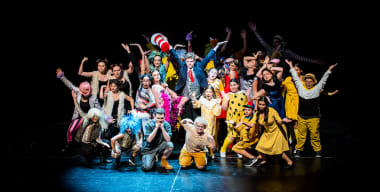Choosing a school for a distractible child
Exploring a distractible child's school fit
Kids vary widely in their ability to focus or concentrate in school: while some find this quite easy, others don’t. Don’t underestimate the importance of your child’s focus on school choice: it can profoundly affect the kind of learning environment, and hence school, that’s right for them.
Distractible kids often struggle to sustain their concentration in school. They find it challenging to focus for long periods of time and follow what’s going on in class.
Below, we identify key points you should reflect on when considering 10 different school types for your distractible child. Note: our aim isn’t to tell you whether a school type is right or wrong for you, but to highlight some critical factors you should consider when making your decision.
To learn about how to choose the right school in general, read the Our Kids’ step-by-step advice guide and our expert tips. To get school-choice advice customized to your child's unique traits, create a child profile through your user account and read our seven ways to choose a school based on your child's needs (i.e., overall fit, more academic challenge, social struggles, academic struggles, intensive learning interests, university preparation, and special needs.).
Distractible kids’ fit in 10 school types
On this page:
School size
Gender
Curriculum
Living arrangements
School size
Big school (151+ students)
If you’re considering a big school for your distractible child, look into its classroom sizes and teaching and learning approach. Distractible kids often do better in smaller classrooms with plenty of individualized learning and one-on-one support, as this can help them sustain their concentration.
Also, “Ask what strategies a school has in place to engage and motivate students,” says Stacey Jacobs, Toronto-based education consultant at Clear Path Educational Consulting. “For instance, do they have flexible seating and innovative furniture?”
Bigger schools tend to have a wider range of extracurriculars to choose from, which can help your child to pursue an interest or develop a passion. And, “Research shows that when students have something to look forward to after school, they’re often better able to focus during the day,” says Janyce Lastman, Toronto-based education consultant at The Tutor Group. “This can really help them renew their energy and recharge their batteries.”
Small school (150 students or less)
Smaller schools with small classrooms often provide more personalized attention and one-and-one support, which often helps distractible kids engage with their studies and sustain their focus. Since they’re conducive to group work, they tend to be more interactive, which your child may find invigorating.
Just keep in mind the law of diminishing returns regarding class size. While a class of 12 or 15 students can boost engagement, a class of 4 or 5 can reduce it, since there are too few voices and perspectives to generate much meaningful interaction and discussion.
The intimacy of smaller schools and classes can also help your child connect with the student community. “Small schools often have a family-like feeling, because the class sizes are so small,” say Ann and Karen Wolff of Wolff Educational Services. “They form a sense of community across the grades, with cross-grade friendships, relationships, and often, leadership opportunities.”
Gender
Coed school
Coed schools require your child to negotiate the complexities of boy-girl interactions. While many kids manage this well, this can sometimes be challenging for kids who are more distractible. Ask a school about its student culture and boy-girl dynamic to ensure your child is the right fit.
Of course, by going to school with boys and girls, your child will enjoy a wider range of social experiences: they’ll have the opportunity to learn from the perspectives of both boys and girls. As one parent told us: “My son really enjoyed spending time and making friends with boys and girls, which he rarely did outside of class. He also learned a lot about how girls and boys sometimes react differently in certain situations.”
Girls' school
In a girls-only school, your daughter can focus on her studies without having to negotiate the complexities of a boy-girl environment. Since boy-girl relations can be especially distracting for less focused girls, this can help your daughter engage more fully with her studies.
Also, “Confidence and self-esteem can be significant benefits of girls’ schools,” says Una Malcolm, Director of Bright Light Learners. “Girls' schools may promote a sense of security and comfort, which can allow girls to feel confident in their learning environment and more comfortable taking academic risks.”
Of course, since your daughter won’t be learning with boys, aim to give her many opportunities to interact with them outside of school, so she can gain a wider scope of social experiences, where she’ll learn from the perspective of girls and boys.
Boys' school
Since they often cater to active boys, boys’ schools tend to provide plenty of time for your son to stretch his legs, move around, and get physical. This can be a big perk for boys who are distractible and more energetic. “In an all-boys environment, boys learn to harness their energy in appropriate social ways, which can serve them well in the schoolyard, classroom, and beyond,” say Ann and Karen Wolff, Toronto-based education consultants at Wolff Educational Services. Also, many boys' schools have a special focus on group and experiential learning, which some distractible boys find engaging and stimulating.
To ensure a particular boys’ school is the right fit for your son, inquire about its approach to social and personal development and boys’ education. For instance, ask: how do you encourage boys to seek out responsibility and leadership opportunities? And, how do you help them with their executive functioning skills?
Curriculum
Montessori school
At a Montessori school, your child will often work independently on their own tasks, e.g., during two-hour-plus uninterrupted work periods, which can benefit kids who get distracted by too much stimulation. Also, independent study time can boost a child’s ability to concentrate and sustain their concentration, as professor of psychology and renowned Montessori researcher Angeline Lilard points out in Montessori: The Science Behind the Genius.
That said, since some kids with shorter attention spans will find it more challenging to work independently for long periods of time, carefully weigh the pros and cons of this learning environment for your child.
Finally, if you’re considering a Montessori school for your distractible child, make sure to look into the amount of unstructured social time it provides. Some Montessori schools don’t have recess, and may limit free time, which is often when kids get their most stimulation and which gives them a chance to renew their energy. This is especially important if your child is social, energetic, and enjoys physical activities.
International Baccalaureate school
The IB’s heavy focus on group work, and its highly social and collaborative learning environment, can help your child sustain their focus. That said, some distractible kids may need more individualized learning and one-on-one support than some IB schools offer. “Since different IB schools have different teaching and learning approaches,” says Dona Matthews, Toronto-based education consultant and co-author (with Joanne Foster) of Beyond Intelligence, “talk to IB school directors and staff to determine whether your child is a good fit.”
Reggio Emilia school
In Reggio Emilia schools, teachers consider each child’s relationship to one another and aim to promote positive connections between them, which can often help distractible kids stay engaged in class. The warm, community feel of the Reggio classroom—which is set up to promote lots of interaction—can help your child feel invigorated, focus on their work, and be more productive.
Just make sure any Reggio Emilia school isn’t too stimulating: know your child and how much stimulation they can handle. And more generally, make sure the school provides the right overall environment for your distractible child: for instance, if they’re likely to benefit from plenty of individualized learning and one-on-one support, ensure this is provided.
Language immersion school
If you’re considering a language immersion school for your distractible child, ensure they offer plenty of individualized learning and one-on-one support. Since these schools require students to learn all or most of their subjects in a second language, they can sometimes be taxing for kids who are distractible. This is especially true if they struggle with languages in particular or academics in general.
That said, if your child enjoys learning languages and is academically-oriented, a language immersion program can help bolster their ability to focus and sustain their concentration. Talk to school directors, education consultants, and others in the know to help gauge whether your child is likely to be a good fit.
Living arrangements
Boarding school
Many distractible kids enjoy the vibrant student community of boarding schools. Interacting and working with kids away from home and in a new environment can open up new learning and social pathways, which can be stimulating and can cultivate sustained concentration.
Just make sure a school’s teaching and learning approach is suitable for your child. “For instance, your child may benefit from extra individualized attention and one-on-one support,” say Ann and Karen Wolff of Wolff Educational Services. “If so, you’ll want to make sure a school provides these things and implements whatever other educational practices suit their academic profile and personality.”
Distractible kids’ school fit: key take-homes
- Distractible kids often do better in schools with smaller classes, which tend to provide calmer and more engaging learning environments. No matter the size, ensure a school provides plenty of one-on-one support and individualized learning to help build and sustain your child’s focus.
- While negotiating boy-girl relations can be a challenge for some distractible kids, many enjoy learning from the perspectives of both genders. Single-gender schools can allow your son or daughter to focus on their studies free of this potential distraction.
- At a Montessori school, kids often work independently on their own tasks, e.g., during two-hour=plus uninterrupted work periods, which can benefit those who get distracted by too much stimulation.
- The warm, community feel of the Reggio Emilia classroom—which is set up to promote lots of interaction—can help your child feel stimulated, focus on their work, and be more productive.









